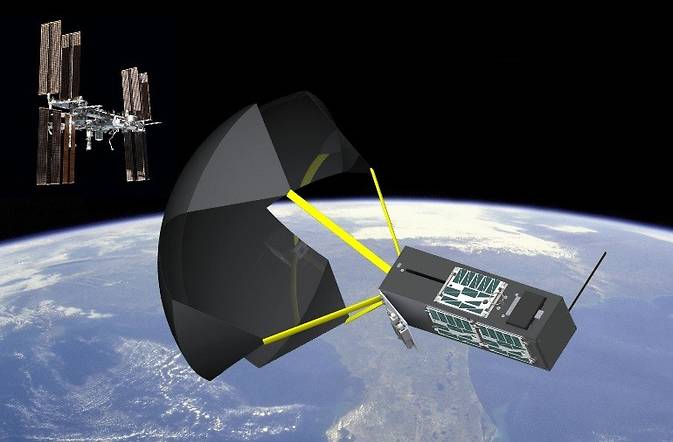NASA mission controllers confirmed that a small satellite launched from the International Space Station at 5:30 p.m. PST on Tuesday, March 3, has successfully entered its orbit, setting the stage to test technology that could enable rapid return of payloads from space. Over the next four weeks, the TechEdSat-4 satellite will deploy a second-generation exo-brake, an aerodynamic drag device, to perform a maneuver that will cause the satellite to de-orbit and re-enter Earth’s atmosphere.
“The exo-brake is a self-stabilizing exospheric deorbiting mechanism that will allow us to return a payload to Earth fairly rapidly from an orbital platform, like the International Space Station,” said Marcus Murbach, the TechEdSat-4 principal investigator at NASA’s Ames Research Center in Moffett Field, California. “We were able to sendcommands and receive data to and from the satellite via the onboard modem using only a laptop and email account. This capability may greatlybenefit the entire nanosatellite community.”
About 30 minutes after the Nanoracks CubeSat Deployer jettisoned it from the space station, the autonomous free-flying satellite powered on. At approximately 8 p.m., the spacecraft received a command via email and deployed its specially-designed parachute-like exo-brake, which operates as a passivedrag device at the extremely low pressures found at the top of the atmosphere. Engineers also confirmed the satellite has demonstrated new satellite-to-satellite communications technologies to provide precise information about the spacecraft’s health and position. TechEdSat-4 arrived at the station aboard Orbital ATK’s Cygnus spacecraft July 16, 2014.
TechEdSat-4 is equipped with a short-burst data satellite modem combined with a GPS receiver to perform communications functions, including providing data about the spacecraft’s health, space environment and location. Together, these technologies replace ground stations used for tracking, rapid data retrieval and uplink capability, and permit satellite control via secure email.
The ability to accurately re-enter Earth’s atmosphere will eventually enable the safe return of scientific samples and valuable cargo from orbital platforms at a lower cost than larger cargo and transfer vehicles. In addition, Murbach and his team intend for this technology to help enable future small or nanosatellite missions to the surface of Mars and other planetary bodies in the solar system.
“We’ve already developed a sample canister that during atmospheric re-entry could slip out the back of the satellite and safely be recovered on Earth,” said Murbach. “This could also be adapted to future Mars satellites as a piggy-back or ride-along payload that could jettison independently and study the mid-latitude or other scientifically interesting regions of Mars. Currently, it is extremely challenging to access these sites.”
TechEdSat-4 is the first NASA satellite to jettison from the Nanoracks CubeSat Deployer and the fourth satellite in the TechEdSat series to successfully achieve orbit. The TechEdSat series, a technology education collaboration with San Jose State University (SJSU) in California and the University of Idaho (UI) in Moscow, Idaho, uses the standard CubeSat structure, which measures one unit (1U) as approximately four inches cubed (10 centimeters cubed). TechEdSat-4 is a 3U satellite measuring approximately 12-by-four-by-four inches (10-by-10-by-30 centimeters) and weighing approximately five pounds.
Previously, TechEdSat-1, a 1U CubeSat released from the Japanese Small Satellite Orbital Deployer (JSSOD) aboard the station in 2012, successfully demonstrated use of the basic communications subsystem and radiation-tolerant controller.
It functioned in orbit for seven months until it re-entered Earth’s atmosphere. It was followed by a successful satellite communication system flight test in April 2013 with TechEdSat-2, a 1U CubeSat. TechEdSat-3, a 3U CubeSat released from the JSSOD in 2013, was the first exo-brake to deploy and the first nanosatellite of its size to deploy from the station.
Ames currently is working on the next iteration in the series. The TechEdSat-5 satellite, scheduled for launch in 2015, will be very similar to the TechEdSat-4 design. It will introduce a modulating exo-brake capable of changing its surface area allowing the satellite to more precisely enter the atmosphere.
TechEdSat-4 was developed, integrated and tested at Ames by student interns with the support of co-investigators Periklis Papadopoulos, from SJSU, and DavidAtkinson, from UI. TechEdSat-4 is funded by Ames. The total cost of the satellite was less than $50,000 because the team primarily used commercial off-the-shelf hardware that was rigorously tested and simplified the design and mission objectives.
“One of the great things about this collaboration is the experience our university students and interns get at an early point in their careers,” said Papadopoulos. “With this experience, many of our interns have started successful careers at NASA or in private industry – which is a great benefit that NASA uniquely provides.”











